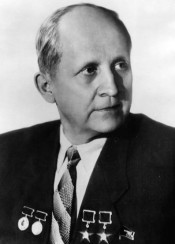
Soviet aircraft designer Pavel Osipovich Sukhoi (1895–1975) was born
On 10 (22) July 1895 Pavel Osipovich Sukhoi, an outstanding Soviet aircraft designer, twice Hero of Socialist Labour (1957, 1965), one of the founders of Soviet jet and supersonic aviation was born.
Pavel Osipovich Sukhoi was born in the village of Glubokoye, Disna district, Vilna province, Russian Empire (now the town of Glubokoye, Vitebsk region, Belarus), in the family of a public school teacher Osip Andreyevich Sukhoi and Elizaveta Yakovlevna Gisich.
In 1900 the family moved to Gomel. From 1905 to 1914 P.O. Sukhoi studied at the Gomel Alexander Gymnasium for Men, graduating with a silver medal. Under the impression of demonstration flights on the aeroplane of the Russian aviator S.I. Utochkin he became interested in aviation and decided to continue his education in Moscow. In September 1914, he entered the Mathematics Department of the Imperial Moscow University (now Lomonosov Moscow State University). After studying for a year, he entered the Imperial Moscow Technical School, the only educational institution in the Russian Empire where theoretical and technical problems of aeronautics were studied. He became a member of the aeronautics circle, which was led by Professor N.E. Zhukovsky, the founder of hydro- and aerodynamics.
In 1916 he was drafted into the army, after training at the school of warrant officers he was sent to the front as an artilleryman. In March 1918, after the collapse of the Eastern Front and the Brest Peace Treaty, he returned to Moscow with the intention of completing his education, but the Technical School was closed, and P. O. Sukhoi was forced to return to his parents in Gomel, where he found a job as a mathematics teacher at the School for Children of Railwaymen.
In the autumn of 1921, after the decree of the RSFSR SNK on the return of students to higher education, he continued his studies at the Technical School. Graduated in 1925, having defended his diploma project "Single-seat fighter with a 300 horsepower engine", prepared under the guidance of aircraft designer A. N. Tupolev. He began to work as a design engineer in the design bureau (KB) of A. N. Tupolev in the Central Aerohydrodynamic Institute (TsAGI), founded in 1918 by N. E. Zhukovsky. In the following years he held the positions of head of design teams and deputy chief designer. During this period, under the supervision of A.N. Tupolev, P.O. Sukhoi designed the I-4 and I-14 fighters (the first USSR monoplane fighter with retractable landing gear), the ANT-25 and ANT-37bis "Rodina" aeroplanes.
From February 1939 to April 1940, P. O. Sukhoi was Chief Designer of Aircraft Factory No. 135 in Kharkov, and took part in the development of the Ivanov aircraft (ANT-51), which resulted in the creation of the Su-2 and its modification, the Su-4, which were widely used in the early years of the Great Patriotic War. From April 1940 to November 1949, P. O. Sukhoi was Chief Designer of the Design Bureau of Aircraft Factory No. 289, based at a number of enterprises in Moscow and the Moscow region. During the war he developed the Su-6 armoured attack aircraft.
In 1949, P.O. Sukhoi returned to the A.N. Tupolev Design Bureau, and from 1953 he headed his own design bureau, where he began work on jet aircraft, believing that they were the future of aviation. Under his leadership, a number of serial jet combat vehicles were developed, many of which revolutionised aircraft construction: the Su-7 supersonic fighter (1955) (twice the speed of sound), Su-9 (1957), Su-11 (1958), Su-15 (1962), Su-17 fighter-bomber (1966), Su-24 variable sweep front bomber (1970), Su-25 attack aircraft (1975) and others. Two world altitude records (1959, 1962) and two world records for closed-course flight speed (1960, 1962) were set on experimental aircraft T-431 and T-405 designed by P. O. Sukhoi. P.O. Sukhoi also led the development of the Su-27 fourth-generation fighter (1977).
P.O. Sukhoi died on 15 September 1975 from the consequences of pulmonary tuberculosis suffered at the front. He is buried in Moscow at the Novodevichy Cemetery.
The outstanding aircraft designer is twice Hero of Socialist Labour (1957, 1965), holder of three Orders of Lenin (1945, 1957, 1975), the Order of the October Revolution, the Order of the Red Banner of Labour (1938), the Order of the Red Star (1933) and the Order of the Badge of Honour (1936).
During the Great Patriotic War P.O. Sukhoi was awarded the Stalin Prize of the First Degree for the development of the Su-6 attack aircraft. He was also awarded the Lenin Prize (1968), the USSR State Prize (1975, posthumously), the Tupolev Gold Medal No. 1 of the USSR Academy of Sciences (1975, posthumously), and the State Prize of the Russian Federation (1997, posthumously) for his achievements in aircraft construction.
Lit.: Бодрихин Н. Г., Проклов В. С. Павел Сухой. М., 2016; Кузьмина Л. М. Генеральный [авиационный] конструктор Павел Сухой. Страницы жизни. М., 1983; Новиков М. «Су» штурмуют небо // Авиация и космонавтика. 1970. № 7. С. 28–29; Сивков Г. Ф. Готовность номер один. М., 1973; Сивков Г. Ф. Готовность номер один: Шестьдесят лет спустя. М.; Жуковский, 2006.
Based on the materials of Presidential Library:
Пути развития авиации в России / доклад Евладова 1-му окружному Съезду Советов. Челябинск, 1923;

